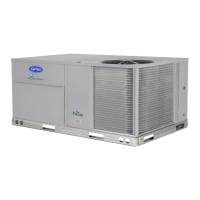78
Economizer Changeover Select
— The control is capable of
performing any one of the following changeover types in addi-
tion to both the dry bulb lockout and the discrete switch input:
E.SEL = 0 none
E.SEL = 1 Differential Dry Bulb Changeover
E.SEL = 2 Outdoor Enthalpy Changeover
E.SEL = 3 Differential Enthalpy Changeover
Differential Dry Bulb Changeover
— As both return air and
outside air temperature sensors are installed as standard on
these units, the user may select this option, E.SEL = 1, to per-
form a qualification of return and outside air in the enabling/
disabling of free cooling. If this option is selected and outside-
air temperature is greater than return-air temperature, free cool-
ing will not be allowed.
Outdoor Enthalpy Changeover
— This option should be used
in climates with higher humidity conditions. Unlike most con-
trol systems that use an enthalpy switch or enthalpy sensor, the
N Series units can use the standard installed outdoor dry bulb
sensor and an accessory relative humidity sensor to calculate
the enthalpy of the air.
Setting E.SEL = 2, requires that the user configure OA.E.C,
the "Outdoor Enthalpy Changeover Select" configuration item,
install an outdoor relative humidity sensor and to make sure a
control expansion module board (CEM) is present. Once the
sensor and board are installed, all the user need do is to enable
ORH.S, the outdoor relative humidity sensor configuration op-
tion. This in turn will enable the CEM board to be read, if it is
not so already, automatically.
NOTE: If the user wishes to disable the enthalpy switch from
running concurrently, a field-supplied jumper must be installed
between TB201 terminals 3 and 4.
Differential Enthalpy Changeover
— This option compares
the outdoor air enthalpy to the return air enthalpy and favors
the airstream with the lowest enthalpy. This option should be
used in climates with high humidity conditions. This option
uses both humidity sensors and dry bulb sensors to calculate
the enthalpy of the outdoor and return air. An accessory out-
door air humidity sensor (ORH.S) and return air humidity sen-
sor (RRH.S) are used. The outdoor air relative humidity sensor
configuration (ORH.S) and return air humidity sensor configu-
ration (Configuration
SENS
RRH.S) must be enabled.
NOTE: If the user wishes to disable the enthalpy switch from
running concurrently, a field-supplied jumper must be installed
between TB201 terminals 3 and 4.
Outdoor Dewpoint Limit Check
— If an outdoor relative hu-
midity sensor is installed, the control is able to calculate the
outdoor air dewpoint temperature and will compare this tem-
perature against the outside air dewpoint temperature limit con-
figuration (O.DEW).
If the outdoor air dewpoint temperature is greater than
O.DEW, "free cooling" will not be allowed.
Custom Psychrometric Curves
— See Figure 16 for an exam-
ple of a custom curve constructed on a psychrometric chart.
Configuring the Economizer to Communicate Via Actuator
"Serial Number" — Every actuator used in the N Series con-
trol system has its own unique serial number. The rooftop con-
trol uses this serial number to communicate with the actuator
over the local equipment network (LEN). These serial numbers
are programmed at the factory and should not need changing.
Should field replacement of an actuator become necessary, it
will be required to configure the serial numbers of the new ac-
tuator. Five individual numbers make up this serial number and
these can be programmed to match the serial number of the ac-
tuator in its "Economizer Actuator Configs" group, ACT.C.
(SN.1.1, SN.1.2, SN.1.3, SN.1.4, SN.1.5, SN.2.1, SN.2.2,
SN.2.3, SN.2.4, SN.2.5, SN.3.1, SN.3.2, SN.3.3, SN.3.4,
SN.3.5).
NOTE: The serial numbers for all "LEN" actuators can be
found inside the control doors of the unit as well as on the actu-
ator itself. If an actuator is replaced in the field, it is a good
idea to remove the additional peel off serial number sticker on
the actuator and cover up the old one inside the control doors.
35
40
45
50
55
60
65
35
40 45
50 55
60 65
10
15
70
75
80
85
70 75
80 85
90 95
100 105
110
115
20 25
30
35
40
45
50
10%
20%
30%
40%
50%
60%
70%
80%
90%
ENTHALPY
RELATIVE HUMIDITY
DEWPOINT TEMPERATURE
DRY BULB TEMPERATURE
Fig. 16 — Custom Changeover Curve Example
a48-8722

